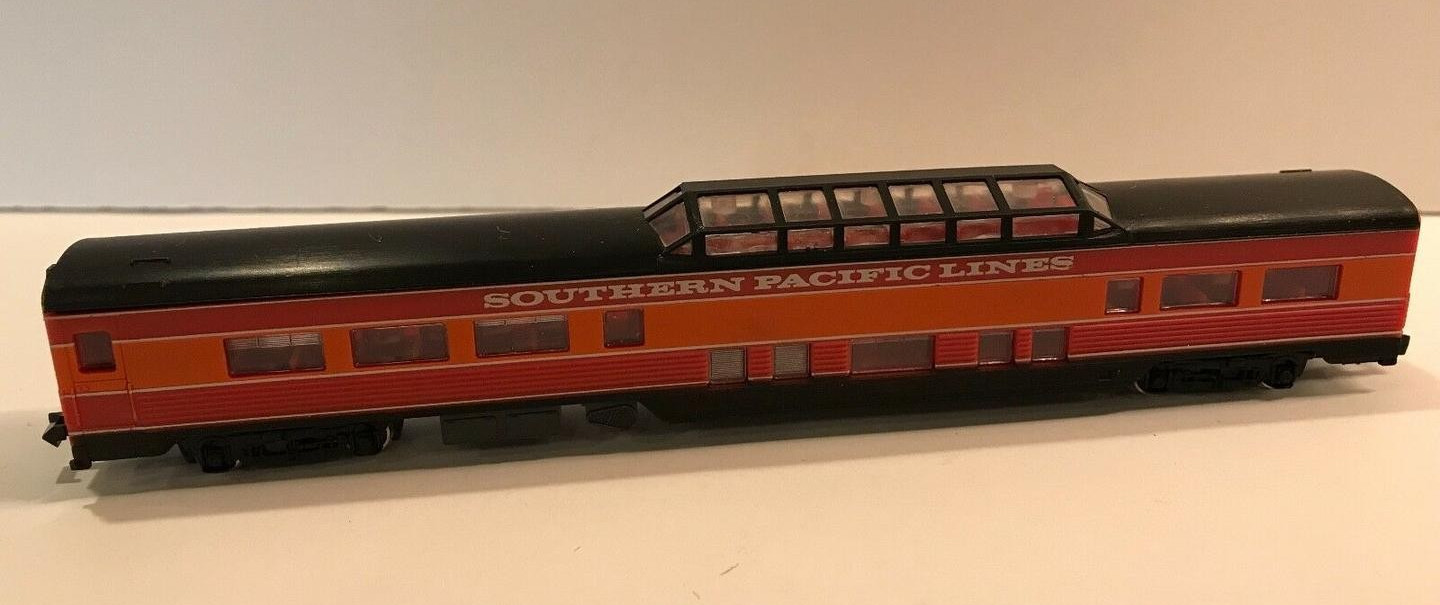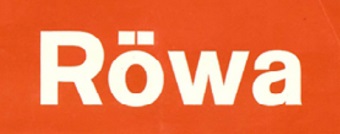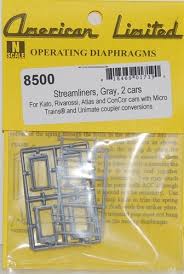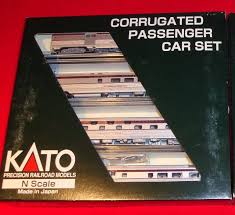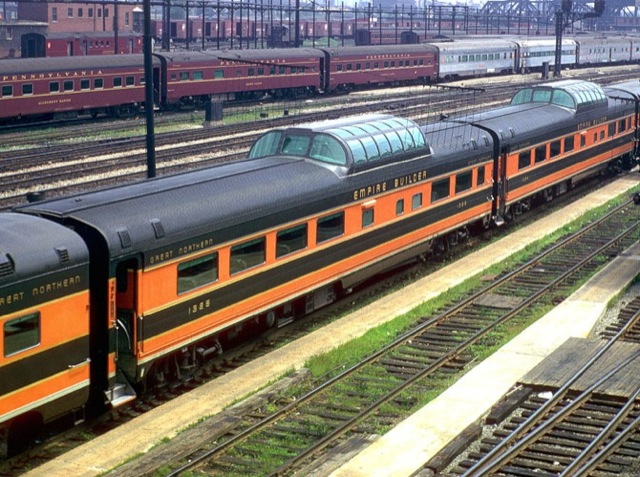Model Information: These cars were originally manufactured for MRC by Röwa (Germany) in the end 1960s-early 1970s. Röwa also sold them under its own brand. Post-MRC, Con-Cor distributed them for a while under its brand name and attempted to acquire the tooling in order to set up production of these cars at Rivarossi. However, said tooling was eventually lost (or confiscated) and these models subsequently vanished from the face of the earth. They have metal window frames, close-coupling, diaphragms and venetian blinds in the windows. Some come equipped with interior lighting.
This model was made after the Pullman Dome, but not matching a particular prototype. The lower corrugated part was similar to the ATSF Pleasure domes, but the dome itself is similar to the B&O Colombian dome; the sides' windows arrangement could have been inspired from Wabash and Texas & Pacific domes.
See here for more details.
This model was made after the Pullman Dome, but not matching a particular prototype. The lower corrugated part was similar to the ATSF Pleasure domes, but the dome itself is similar to the B&O Colombian dome; the sides' windows arrangement could have been inspired from Wabash and Texas & Pacific domes.
See here for more details.
Prototype History: The Vista-Dome is a deluxe coach with a glass compartment rising out of the roof. This railroad passenger car has a second floor with 24 or 30 seats, lots of windows and no obstructions. The front and rear walls of the dome are windows. The entire side of the dome is made of windows. Curved glass is used to transition from the side to the roofing on vista-domes. All of this glass allows passengers to view the all the great and vast scenery. At night only the only lights used are to illuminate the floor allowing passengers to look up and watch for falling stars. A Vista-Dome has only one set of stairs up and down. It is not the place to hide from a ticket collecting conductor.
The Chicago Burlington & Quincy Railroad, the Burlington Railroad, introduced the Vista-Dome passenger car into regular service in 1947 on it's Twin Zephyr train. It was part of the standard equipment of the California Zephyr train when that train started running on March 20, 1949. The Twin Cities Zephyr train included 5 Vista-Dome cars. Standard height dome cars, 24 inches over the roofline were not suitable for service on most eastern railroads because of clearance problems. Budd built domes with a 19 1/2 inch dome top for eastern service. The Baltimore and Ohio Railroad was the only pre-Amtrak east coast railroad that had Vista-Domes in revenue service. The domes were a part of the Columbian and Capitol trains.
More photos on this website.
The Chicago Burlington & Quincy Railroad, the Burlington Railroad, introduced the Vista-Dome passenger car into regular service in 1947 on it's Twin Zephyr train. It was part of the standard equipment of the California Zephyr train when that train started running on March 20, 1949. The Twin Cities Zephyr train included 5 Vista-Dome cars. Standard height dome cars, 24 inches over the roofline were not suitable for service on most eastern railroads because of clearance problems. Budd built domes with a 19 1/2 inch dome top for eastern service. The Baltimore and Ohio Railroad was the only pre-Amtrak east coast railroad that had Vista-Domes in revenue service. The domes were a part of the Columbian and Capitol trains.
More photos on this website.
Road Name History:  The Southern Pacific Transportation Company (reporting mark SP), earlier Southern Pacific Railroad and Southern Pacific Company, and usually called the Southern Pacific or (from the railroad's initials) Espee, was an American Class I railroad. It was absorbed in 1988 by the company that controlled the Denver and Rio Grande Western Railroad and eight years later became part of the Union Pacific Railroad.
The Southern Pacific Transportation Company (reporting mark SP), earlier Southern Pacific Railroad and Southern Pacific Company, and usually called the Southern Pacific or (from the railroad's initials) Espee, was an American Class I railroad. It was absorbed in 1988 by the company that controlled the Denver and Rio Grande Western Railroad and eight years later became part of the Union Pacific Railroad.
The railroad was founded as a land holding company in 1865, later acquiring the Central Pacific Railroad by lease. By 1900 the Southern Pacific Company was a major railroad system incorporating many smaller companies, such as the Texas and New Orleans Railroad and Morgan's Louisiana and Texas Railroad. It extended from New Orleans through Texas to El Paso, across New Mexico and through Tucson, to Los Angeles, through most of California, including San Francisco and Sacramento. Central Pacific lines extended east across Nevada to Ogden, Utah, and reached north through Oregon to Portland. Other subsidiaries eventually included the St. Louis Southwestern Railway (Cotton Belt), the Northwestern Pacific Railroad at 328 miles (528 km), the 1,331 miles (2,142 km) Southern Pacific Railroad of Mexico, and a variety of 3 ft (914 mm) narrow gauge routes.
In 1929 SP/T&NO operated 13848 route-miles not including Cotton Belt, whose purchase of the Golden State Route circa 1980 nearly doubled its size to 3,085 miles (4,965 km), bringing total SP/SSW mileage to around 13,508 miles (21,739 km).
By the 1980s route mileage had dropped to 10,423 miles (16,774 km), mainly due to the pruning of branch lines. In 1988 the Southern Pacific was taken over by D&RGW parent Rio Grande Industries. The combined railroad kept the Southern Pacific name due to its brand recognition in the railroad industry and with customers of both constituent railroads. Along with the addition of the SPCSL Corporation route from Chicago to St. Louis, the total length of the D&RGW/SP/SSW system was 15,959 miles (25,684 km).
By 1996 years of financial problems had dropped SP's mileage to 13,715 miles (22,072 km), and it was taken over by the Union Pacific Railroad.
Read more on Wikipedia.

The railroad was founded as a land holding company in 1865, later acquiring the Central Pacific Railroad by lease. By 1900 the Southern Pacific Company was a major railroad system incorporating many smaller companies, such as the Texas and New Orleans Railroad and Morgan's Louisiana and Texas Railroad. It extended from New Orleans through Texas to El Paso, across New Mexico and through Tucson, to Los Angeles, through most of California, including San Francisco and Sacramento. Central Pacific lines extended east across Nevada to Ogden, Utah, and reached north through Oregon to Portland. Other subsidiaries eventually included the St. Louis Southwestern Railway (Cotton Belt), the Northwestern Pacific Railroad at 328 miles (528 km), the 1,331 miles (2,142 km) Southern Pacific Railroad of Mexico, and a variety of 3 ft (914 mm) narrow gauge routes.
In 1929 SP/T&NO operated 13848 route-miles not including Cotton Belt, whose purchase of the Golden State Route circa 1980 nearly doubled its size to 3,085 miles (4,965 km), bringing total SP/SSW mileage to around 13,508 miles (21,739 km).
By the 1980s route mileage had dropped to 10,423 miles (16,774 km), mainly due to the pruning of branch lines. In 1988 the Southern Pacific was taken over by D&RGW parent Rio Grande Industries. The combined railroad kept the Southern Pacific name due to its brand recognition in the railroad industry and with customers of both constituent railroads. Along with the addition of the SPCSL Corporation route from Chicago to St. Louis, the total length of the D&RGW/SP/SSW system was 15,959 miles (25,684 km).
By 1996 years of financial problems had dropped SP's mileage to 13,715 miles (22,072 km), and it was taken over by the Union Pacific Railroad.
Read more on Wikipedia.
Brand/Importer Information: Con-Cor has been in business since 1962. Many things have changed over time as originally they were a complete manufacturing operation in the USA and at one time had upwards of 45 employees. They not only designed the models,but they also built their own molds, did injection molding, painting, printing and packaging on their models.
Currently, most of their manufacturing has been moved overseas and now they import 90% of their products as totally finished goods, or in finished components. They only do some incidental manufacturing today within the USA.
Important Note: The Con-Cor product numbering can be very confusing. Please see here in the article how to properly enter Con-Cor stock numbers in the TroveStar database.
Currently, most of their manufacturing has been moved overseas and now they import 90% of their products as totally finished goods, or in finished components. They only do some incidental manufacturing today within the USA.
Important Note: The Con-Cor product numbering can be very confusing. Please see here in the article how to properly enter Con-Cor stock numbers in the TroveStar database.
Manufacturer Information: Röwa was founded in 1961 by Willy Ade and Horst Röchling, the company name being an acronym of their combined names. For several years, much of Röwa’s energies were directed toward developing products for other model train manufacturers, notably Trix of Germany and, on occasion, Roco of Austria.
Production of model trains under the Röwa name began in the late 1960’s, ca. 1968. Much of the company’s products were in H0-Scale, but there was some interesting production in N-Scale.
The Röwa American-prototype N-Scale items were marketed in the United States by Model Rectifier Corporation (MRC) for a period of a few years. Both the locomotives and passenger cars were subsequently marketed by other companies in successive years. For example, Brawa and Con-Cor marketed the N&W Y-6b Mallet-type, and the Berkshire may have also been marketed in the same way. Con-Cor owned the passenger car tooling for a period of time, producing until the die-molds went out of production tolerances.
Röwa ended production around 1974 and the manufacturing tools and dies used to produce the trains were sold to other companies.
From this website.
Production of model trains under the Röwa name began in the late 1960’s, ca. 1968. Much of the company’s products were in H0-Scale, but there was some interesting production in N-Scale.
The Röwa American-prototype N-Scale items were marketed in the United States by Model Rectifier Corporation (MRC) for a period of a few years. Both the locomotives and passenger cars were subsequently marketed by other companies in successive years. For example, Brawa and Con-Cor marketed the N&W Y-6b Mallet-type, and the Berkshire may have also been marketed in the same way. Con-Cor owned the passenger car tooling for a period of time, producing until the die-molds went out of production tolerances.
Röwa ended production around 1974 and the manufacturing tools and dies used to produce the trains were sold to other companies.
From this website.
Item created by: gdm on 2017-03-06 10:05:05. Last edited by gdm on 2020-12-23 07:48:35
If you see errors or missing data in this entry, please feel free to log in and edit it. Anyone with a Gmail account can log in instantly.
If you see errors or missing data in this entry, please feel free to log in and edit it. Anyone with a Gmail account can log in instantly.


